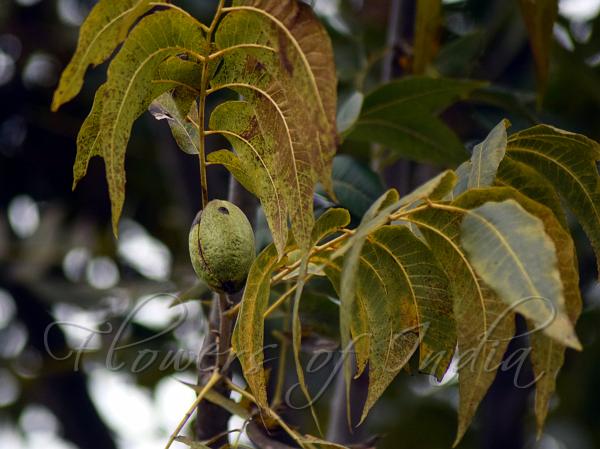|
| Pecan Walnut |
|

|

|
|
|
|
Photo: |
Botanical name: Carya illinoiensis Family: Juglandaceae (Walnut family)
Synonyms: Carya pecan, Juglans pecan, Juglans oliviformis
Synonyms: Carya pecan, Juglans pecan, Juglans oliviformis
Pecan Walnut is a tree 70-150 ft tall at maturity,
forming a trunk 2-6 ft across. In open areas, the trunk is relatively
short, while the crown has a globoid form from widely spreading
branches. Small branches are gray and smooth, while young twigs are
brown and usually velvet-hairy. Alternate compound leaves 1-2 ft long
develop along the twigs; they are odd-pinnate, consisting of 9-17
leaflets. The leaflets are 5-17 cm long and 1.2-6 cm across,
lanceshaped or lanceshaped-oblong in shape, curved to one side, and
coarsely sawtoothedd along their margins. The leaflets have asymmetric
bases and elongated tips. Pecan is monoecious with both male and female
florets on the same tree. Short female spikes develop at the tips of
some twigs; each spike has 2-10 greenish female florets. Individual
florets are about 6 mm long and 3 mm across, consisting of a short
tubular calyx, 4 bractlets of unequal size, and a pistil. Drooping male
catkins about 4-6 inches long develop from short spurs along the twigs;
these catkins are yellowish green and usually occur in groups of 3.
Individual male florets have a 3-lobed bractlet and 4-6 stamens; the
central lobe of the bractlet is longer than the lateral lobes. In the
summer, fertile female florets are replaced by clusters of 1-6 nuts
with thin husks. These fruits are about 2 inches long, 1 inch across,
and ovoid-oblongoid in shape. Along the length of each fruit, there are
4 short wings. The husk surface is smooth and hairless; it is initially
light green, but later becomes brown or black. A mature fruit partially
divides into 4 segments (along its wings) to release the nut. The nut
surface is light brown and smooth; the interior of the nut has sweet
edible meat. This tree reproduces by reseeding itself. Pecan Walnut is
native to America, but cultivated worldwide.
| Identification credit: Ashutosh Sharma | Photographed in Kullu District, Himachal Pradesh. |
• Is this flower misidentified? If yes,